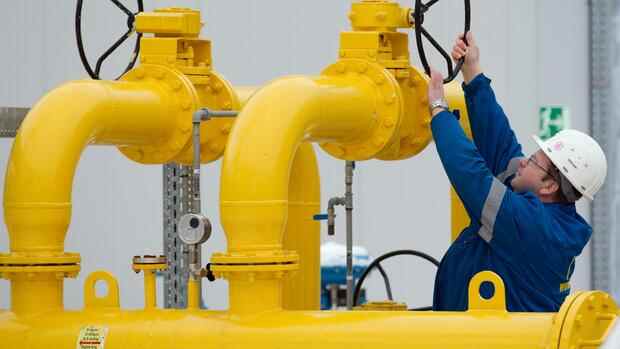Dusseldorf Energy markets reacted violently to Russia’s attack on Ukraine on Thursday. On the gas market in particular, prices have skyrocketed, driven by growing fears of a further shortage in supply volumes: on the Dutch TTF exchange, a megawatt hour (MWh) of natural gas recently cost more than 136 euros, rising by 54 percent within a few hours to.
The threat by Russia’s ex-president Dmitry Medvedev that gas prices in Europe will now double after the Nord Stream 2 pipeline has been temporarily shut down could come true faster than feared. On Tuesday, Medvedev had forecast gas prices for Europeans of “soon to be 2,000 euros per 1,000 cubic meters of gas”. At the time of his statement, the price on the Amsterdam Stock Exchange was 830 euros or 79 euros per megawatt.
Oil is also significantly more expensive: the price of a barrel of North Sea Brent jumped to $103 from just under $97 the previous evening. The US variety WTI also increased by more than six percent.
Russian President Vladimir Putin officially ordered the attack on eastern Ukraine on Thursday morning. US President Joe Biden, the Western allies and NATO sharply condemned Putin’s actions and announced further sanctions.
Top jobs of the day
Find the best jobs now and
be notified by email.
While the prices for coal, oil and gas reacted quite moderately to events in Eastern Europe during the course of the week, prices have now risen significantly. “So the market is pricing in a massive supply shortage,” says Commerzbank analyst Carsten Fritsch, describing the market’s reaction.
Gas expert Michael Stoppard from the market research company IHS Markit told Handelsblatt: “We saw the highest gas price to date in December, when a megawatt hour of natural gas cost 180 euros. Now this record price could even be exceeded.” However, Stoppard does not believe that prices will remain at this level for months.
Thanks to milder temperatures and a foreseeable end to the heating season, Putin has lost one of his biggest threats, at least in the short term. At the moment, the European storage levels are still at a low level, but are only just over 30 percent full on average. However, according to the market research company ICIS, they are now back in the “normal range”.
Delivery disruptions from Ukraine are likely
“We believe disruption of gas flows from Russia, primarily through Ukraine, is possible. But that primarily relates to the consequences of Russia’s military actions,” says Stoppard. However, he still thinks it is unlikely that Moscow will deliberately stop supplying gas to Europe, i.e. break supply contracts.

The pipelines that supply Europe and Germany with natural gas partly run through Ukraine. Among them are the “Brotherhood” pipeline with a capacity of 100 billion cubic meters and the Soyuz pipeline with a capacity of 32 billion cubic meters. Should the connections be damaged or destroyed, natural gas will also reach Western Europe through Nord Stream 1 across the Baltic Sea and through the Yamal Pipeline via Belarus and Poland.
The total capacity of these pipelines is significantly higher than the annual gas imports. In 2021, only 40 out of 183 cubic meters flowed through Ukraine. A failure could therefore be compensated for with a view to the security of supply via the remaining lines.
The situation is somewhat different on the oil market: should there be a partial loss of Russian oil supplies, the other major producing countries would only be able to compensate to a limited extent. Russia is one of the largest oil suppliers for Europe, Germany alone imported almost 179 million barrels in 2020.
According to the International Energy Agency (IEA), however, only 2.2 million barrels per day of free production capacity can be activated within a short period of time. That’s 5.1 million barrels over a 90-day period. The US, Japan and Australia are also considering tapping into emergency reserves should supply shortages arise.
In any case, the war between Ukraine and Russia is likely to keep energy prices rising in the future. Coal prices have also been rising for four days. This hits consumers in Europe especially hard, who have been suffering from record prices for electricity, oil and gas for months.
Germany imported almost 179 million barrels from Russia in 2020.
(Photo: dpa)
“Until now, it was thought that prices would normalize again in 2023/2024. However, this crisis is also postponing the lowering of prices. And that would be a huge burden for industry and consumers,” explains energy analyst Fabian Huneke from Energy Brainpool.
After just a few days, the so-called “futures”, i.e. such contracts for 2023/2024, became more expensive. The electricity price for the coming year rose by almost 14 percent on the futures market to almost 157 euros per megawatt hour. As of Wednesday evening, the same contract was up just 7 percent since the start of the week.
Energy costs have been a key driver of inflation in recent months.
And the current developments in Ukraine have triggered further price increases. Economists now fear a further increase in inflation. And the energy costs are likely to drive up further prices in a chain reaction – such as those of fertilizers, aluminum and paper.
More on the Ukraine conflict:

